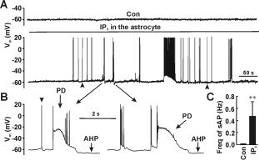ASTROCYTIC GLUTAMATE RELEASE-INDUCED PAROXYSMAL DEPOLARIZATION AND EPILEPTIFORM DISCHARGES IN HIPPOCAMPAL CA1 PYRAMIDAL NEURONS
Abstract number :
C.03
Submission category :
Year :
2005
Submission ID :
31
Source :
www.aesnet.org
Presentation date :
12/3/2005 12:00:00 AM
Published date :
Dec 2, 2005, 06:00 AM
Authors :
1Ning Kang, 1Jun Xu, 2Qiwu Xu, 2Maiken Nedergaard, and 1Jian Kang
A fundamental question in epilepsy is the initiation of paroxysmal activity that generates spontaneous and evoked seizures. A paroxysmal depolarization shift (PDS) has been found in some models of partial-onset seizures and related to paroxysmal activity. Recent studies have suggest that astrocytes release glutamate (Bezzi et al. [italic]Nature[/italic] 391: 281, 1998; Kang et al. Nature Neurosci. 1: 683, 1998; Angulo et al. [italic]J Neurosci[/italic] 24:6920, 2004; Fellin et al. Neuron 43: 729, 2004). Thus, activation of ionotropic glutamate receptors in pyramidal neurons by astrocyte-released glutamate becomes a possible mechanism underlying epileptic seizures. Dual whole-cell patch-clamp recording in pairs of CA1 pyramidal neurons and astrocytes and two-photon laser scanning microscopy are used.
Astrocytes are stimulated by intracellular IP3 or 4-AP. By monitoring astrocytic IP[sub]3[/sub]-induced changes in membrane potential and current and exocytosis of vesicles from astrocytes, we have found that astrocytic glutamate release induces a paroxysmal depolarization (PD) and epileptiform discharges in CA1 pyramidal neurons in hippocampal slices. Intracellular application of inositol 1,4,5-trisphosphate (IP[sub]3[/sub]) into astrocytes induces a tetrodotoxin (TTX)-insensitive slow transient inward current (STC) in both pyramidal neurons and astrocytes. The neuronal STC is blocked by APV plus CNQX indicating that neuronal STC is mediated by ionotropic glutamate receptors leading to the PD and epileptiform discharges. The astrocytic STC is inhibited by the glutamate transport inhibitor TBOA and is a transport current reflecting reuptake of released glutamate into the recorded astrocyte. Fusion of a large vesicle in astrocytes precedes the STC, suggesting that the STC results from astrocytic exocytosis of a glutamate-containing vesicle. In the presence of TTX, the epileptogenic reagent, 4-AP, also induces a similar STC, suggesting a possible pathological function of astrocytic glutamate release in initiation of seizures. Astrocytic exocytosis of a large glutamate-containing vesicle induces a paroxysmal depolarization and epileptiform discharges in pyramidal neurons, suggesting that astrocytic glutamate release may contribute to epileptic seizures.[figure1] (Supported by NIH grants RO1NS39997.)
